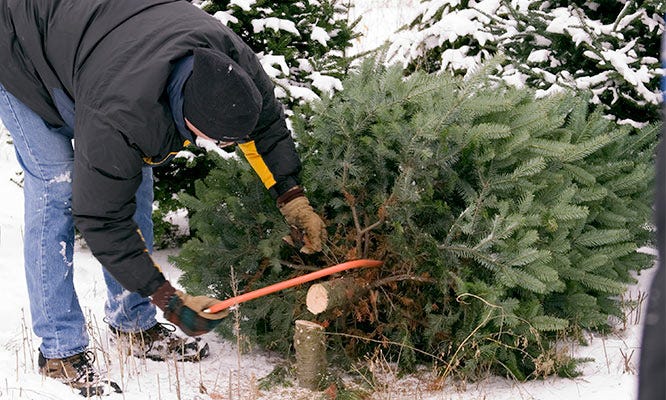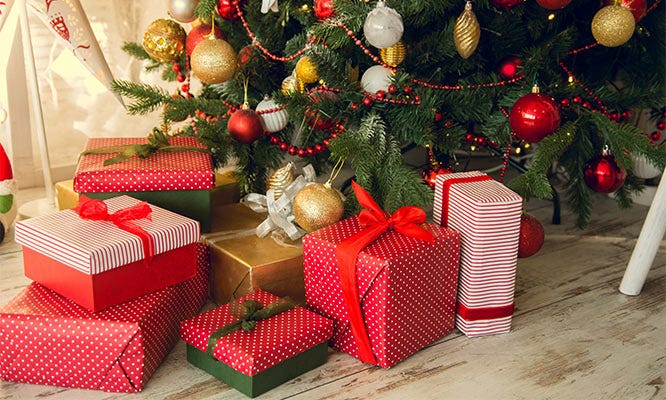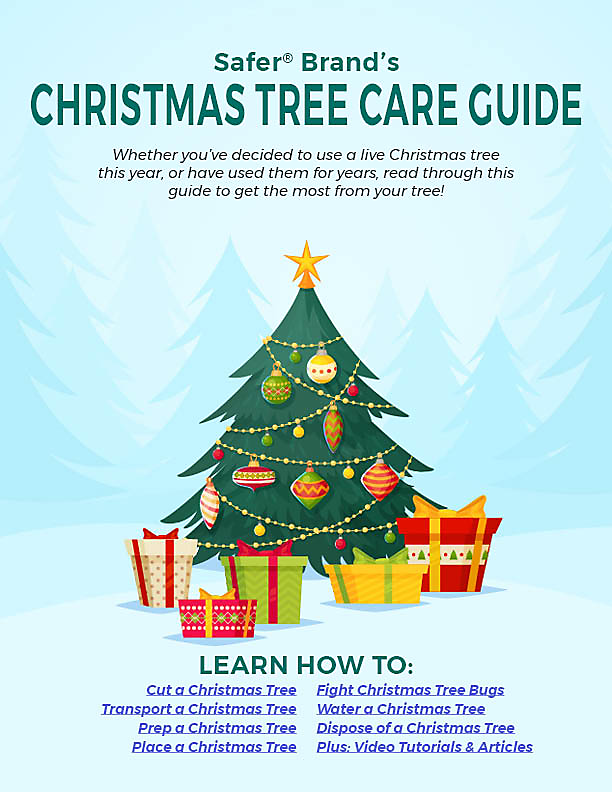
If you're looking to learn how to care for a Christmas Tree, you've come to the right place! Safer® Brand has assembled this handy guide on how to care for live Christmas Trees.
In the Safer® Brand Christmas Tree Care Guide download, you'll learn:
- How to Cut a Christmas Tree
- How to Transport a Christmas Tree
- How to Prep a Christmas Tree Before Bringing it Inside
- How to Set Up a Christmas Tree
- How to Water a Christmas Tree
- How to Battle Christmas Tree Bugs
- How to Dispose of a Christmas Tree
Ready to get your Chirstmas Tree Care Guide? Click the image to download this 11-page guide. Don't want to download it? Keep scrolling for the complete guide.
Also be sure to check out our guide on battling Christmas Tree Bugs!
Whether you’ve decided to use a live Christmas tree this year, or have used them for years, read through this guide to get the most from your tree!
CUTTING A CHRISTMAS TREE

After you’ve selected your tree (and we suggest you get a Noble Fir for its durability and superior appearance), use a pair of pruning shears to remove branches that are low to the ground. Try to clear away at least 6 inches of space.
Next, use a hand saw to cut through the exposed trunk area. To make it easier, have a friend or family member pull on the opposite side of the tree from where you are cutting. This exposes the cutting area more, which allows the saw to move more easily. It also keeps the tree from falling on you.
Leave at least 6 inches of tree’s trunk above the cut. This helps the trunk fit in a tree stand easier.

- Tools: Hand Saw, Pruning Shears, Measuring Tape, Rope, Tarp, Cold Weather Gear
- Quick Tip! Before you head out to cut down a tree, measure the space you’ll need, and don’t forget to include a bit extra for the tree topper.
- Heads Up! In some regions, the U.S. Forest Service allows you to cut your own tree on some national forests. You’ll need a permit to do so, so contact your local Forest Service office!
TRANSPORTING A CHRISTMAS TREE

If you buy on a Christmas Tree Lot, the attendants may or may not help you with tie down. They also may have a netting machine, which squeezes the tree into a more manageable size and shape.
If you’re loading your Christmas Tree without any additional help, you’ll need to secure it in place with rope or straps. First, however, wrap it up your tarp to protect it from drying out. Tarps also keep debris from leaving a mess inside your vehicle, prevent scratches on your paint and also make it easier to tie down. Don’t use bungee cords, which can stretch unexpectedly.

- Tools: Hand Saw, Pruning Shears, Rope or Straps, Tarp, Gloves, Space In or On Your Vehicle
- Quick Tip! When you think you have your tree secured, give it a tug or two to make sure it won’t shift unexpectedly. You should have at least three individual ropes holding the tree to prevent this.
- Heads Up! When loading your tree, put the trunk end toward the front of the car. Avoid highway driving with a Christmas Tree strapped to your roof since the added wind resistance could alter your ability to control the vehicle.
BEFORE BRINGING THE CHRISTMAS TREE INSIDE

When you arrive home with your tree, take a look at your tree and keep an eye out for any bugs or other critters that may be moving around inside its branches. If you see some, consult our critter guide below.
Before you bring your tree inside, take your saw and cut off one inch from the base if it was cut from its roots within the last 24 hours. If you obtained your tree from a tree lot, cut off between four and six inches. This allows for better water uptake.

- Tools: Hand Saw, Gloves
- Quick Tip! Don’t take your lot-purchased tree out of the net until it’s installed in a stand. Trying to maneuver it through the house or into a stand after the tree is “released” is quite difficult. You don’t want all those branches in the way.
- Heads Up! When you unfasten your tree from its tie-down straps or rope, it may spring out to full size, even if its been netted or tied down. Those nets and ropes may have broken or loosened during the ride home, which means you need to be careful.
HOW TO SET UP A CHRISTMAS TREE

Chances are that you already know exactly where your Christmas Tree will go. Just make sure this area is away from vents or heat sources, which can accelerate the tree’s dehydration.
Before attempting to put up your tree, quickly measure it and your space again to make sure you don’t have to make another height adjustment.
Once you’ve made that check, you can insert the tree into the stand. To do so, get some help – one person to guide the trunk and the other to manage the tree. Insert the tree on the spike and tighten the centering screws so they come in contact with the trunk. Now push your tree upwards and check that it’s level while having someone brace it. After any additional adjustments, continue to turn a screw a little, then moving to the next and tightening that one a little. Continue criss-crossing while tightening until all screws are tight.
After its been secured, release it from its netting and prune it into the traditional Christmas Tree shape.

- Tools: Measuring Tape, Tree Stand, Pruning Shears
- Quick Tip! Obtain a stand that easily fits your tree trunk size. If you’re using the same stand as last year, bring it with you when you get your tree and make sure the trunk will fit the stand. The best stands have deep wells with a lot of space between the spike and the centering screws.
- Heads Up! Be Aware that sap may ooze from your tree, and when it makes it into a warm home, the sap can really flow. This is one of the original reasons for a tree skirt, which should extend beyond the diameter of your tree limbs. Tree skirts are also used to catch needles and hide the tree stand.
WATERING YOUR CHRISTMAS TREE

Since your tree no longer has its roots, it needs a lot of help to stay fresh during the time it’s serving as your Christmas Tree. Expect to add water to the tree daily, if not more often, and keep an eye out for pets who may mistake it as a water bowl.
Your tree may not exhibit an even, regular uptake of water, so don’t be surprised if you check it out one day and the base is completely dry.
Remember that keeping your tree well-watered will help it keep its pine needles in place, rather than all over your floor or tree skirt.

- Tools: Water Pitcher or Jug, Calendar Phone App (to remind you to check the water level!)
- Quick Tip! During the first few days inside, check your tree’s water level every 8 hours or so. Expect to provide a lot of water to your tree during its first 24 hours. Some can suck up as much as a gallon of water on their first day inside.
- Heads Up! Some methods for helping a tree survive longer simply do not work, including drilling a hole in the base to help with water uptake or mixing up a special concoction to add to its water.
COMMON CHRISTMAS TREE CRITTERS

Since you’re using a live tree, it may also come with some live bugs and critters attached to it. Your best bet is to let your tree sit outside for 24 hours or so before bringing it inside, which will give any critters an opportunity to move along.
Inside you may experience a number of insects, thanks to the warmer temperatures.
To prepare for these insects, pre-treat your tree before bringing it into your home with:
- Diatomaceous Earth: An insecticidal powder that uses no synthetic chemicals and leaves no scent or odors. Simply dust your tree while it's still outside and shake off excess before bringing it inside.
- Neem Oil Spray: Apply this OMRI Listed® spray to target insects at every growth stage. Use it before trimming your tree or as soon as you spot any pests.
DISPOSING OF THE CHRISTMAS TREE

Leaving your Christmas Tree by the curb for trash collection is one option for getting rid of this holiday decoration, but you have a few more options.
- Mulch: Run it through a mulcher and spread the remains into areas around your home.
- Compost: Strip off the greens and bark and add them to your compost pile. With the help of Ringer® Compost Plus®, you can convert your Christmas Tree into the raw material for your garden.
- Shelter: Rather than hauling it out to the curb, take your tree into a remote corner of your property and leave it there. The tree can serve as a shelter for wildlife through the winter and early spring.
- NOT for use as Firewood: It may seem like a Christmas Tree will make for great firewood, the the sap can create a fire hazard in a chimney.
MORE HELP FOR YOUR HOME
Looking for more ideas on getting the most your lawn, home and garden? Look for more helpful articles when you join Safer® Brand’s on Facebook. Also, at SaferBrand.com, we offer a variety of solutions for organic gardening and lawn care, including dozens of OMRI Listed® products that are compliant for organic gardening.




